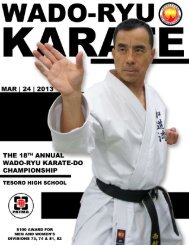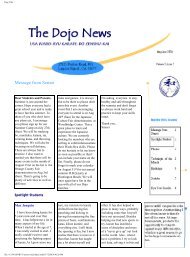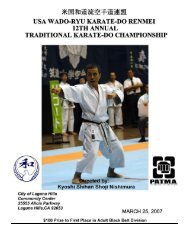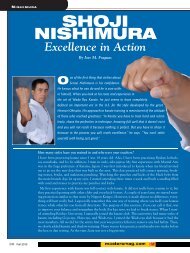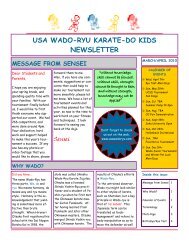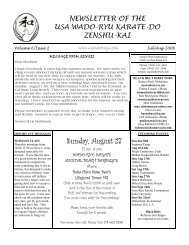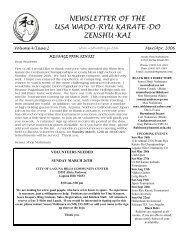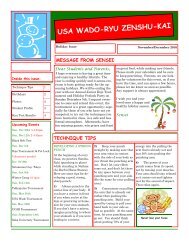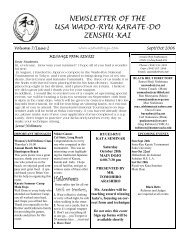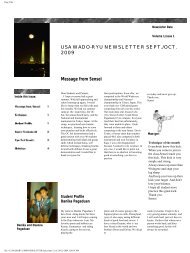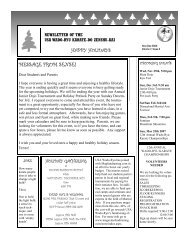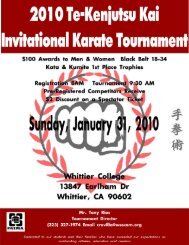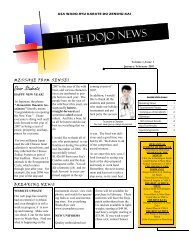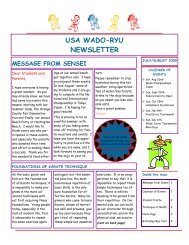Wado-ryu Karate Handbook - USA Wado Ryu Karate-Do
Wado-ryu Karate Handbook - USA Wado Ryu Karate-Do
Wado-ryu Karate Handbook - USA Wado Ryu Karate-Do
- No tags were found...
Create successful ePaper yourself
Turn your PDF publications into a flip-book with our unique Google optimized e-Paper software.
<strong>Wado</strong>-<strong>ryu</strong> <strong>Karate</strong><strong>Handbook</strong>E-mail:usawado@cox.netWeb Site:www.usawado<strong>ryu</strong>.com
Sensei Nishimura welcomes you to class and thanks you for signing up. SenseiNishimura is a 7th Degree Black Belt with 40 years experience. He also has numeroustournament wins and awards, most recently a 3 rd place in the 2002 World Championships inTokyo, Japan. It is his goal to "Foster the spirit of effort" in your child. Although this locationis based out of the park and recreation, <strong>USA</strong> <strong>Wado</strong>-<strong>Ryu</strong> is serious about the commitment toyour child's traditional Japanese martial arts education. The main dojo is located in LagunaNiguel, CA. Visit us on the web at: www.usawado<strong>ryu</strong>.com. Here you will find valuableinformation, as well as a calendar of upcoming events and contact information.The advantages to having classes located and given through the park and recreationdepartment are:* Quality instruction at reasonable fees* Easy access and plenty of parking* No contracts to signSome of the things that are expected from the students are:1. To be respectful to Sensei and other students2. To be willing to learn while in class* Listening and paying attention to Sensei or his helpers* A willingness to take correction in the spirit it is given* Sit quietly and watch. Many things can be learned from sitting andwatching quietly3. The commitment to practice at home (a few minutes everyday make a hugedifference in your child’s progress)4. To learn of Japanese phrases5. To learn the dojo kun6. Students with long hair should pull it back into a ponytail. Soft elastics only.No clips or barrettes.7. Please remove all jewelry and watches before starting class.8. Come dressed with gi and belt properly tied. (ask for help if you are unsurehow to do this)9. Remember your passport. (If you need a passport, please see Sensei)Students will be given a handbook containing the dojo kun and more detailedinformation. Please make sure to go over this with your child(ren).Some important things for parents and observers of class:1. Please turn off or silence your cellular phone. If you need to answer a call,please go outside to do so.2. We respectfully ask that all crying and fussy children who are observingclass, be removed immediately.3. Please no photography or video taping during class.4. Please no conversations during class.The reason you are being asked to observe these rules is for the benefit of your child. All ofthe above items create distractions and take away from your child being able to devote his orher full attention to class. You wouldn’t go into your child’s school classroom and do any ofthe above items. Your child’s karate education is just as important to us.The emphasis of the class will be on traditional Japanese martial arts. Self control and selfdiscipline are the primary goals. This means that horseplay and chatting in class are notallowed.
SparringAt the intermediate and advanced levels students will be given the opportunity to spar.Sensei Nishimura will have for purchase the equipment necessary. You must have thefollowing:1. Helmet2. Gloves3. MouthpieceBoys should also have athletic protection (cup). Stray kicks are not uncommon.These items are mandatory and you will not be allowed to spar without them!The following items are optional but strongly recommended:1. Chest protector2. Shin guardsTestingWhile there is testing after each session, it may not be in your child's best interest to test afterevery session. Every child is different and the goal is to have each child reach his or her fullpotential, and have a good experience. Testing is a very formal process and can beintimidating for some students. If you have any questions about if your child is ready fortesting please consult Sensei. Sensei will try and give you advance warning if he seesthat your child is not going to be ready to test. He will give your child constructive advice onareas to work on.If your child is asked to “wait” to test, please do not see this as a failure, but an opportunityfor your child to grow to his fullest potential. By waiting until the next session to test, he orshe will have more confidence in his or her routine and will have a better feeling aboutthemselves and their accomplishments. Children are quite uncomfortable if they do not dowell, in front of their peers and family. Sensei would rather have a child wait to test, ratherthan be disappointed in front of his or her family and friends. Children know the differencebetween when they have worked to learn something and mastered it and when something isjust “handed” to them because they just showed up. Sensei wants to foster each student’ssense of self esteem, pride and reward their hard work.Some things to keep in mind for testing:1. Students must have attended 80% of class to test. Passport stamps are the“proof” of attendance. <strong>Do</strong>n’t forget your passport!! If you need a passport,see Sensei.2. If you are a green belt or higher, in addition to 80% attendance, you mustattend a seminar, tournament or camp.3. Please let Sensei know 2 weeks before testing if you intend to test. This willinsure that the proper belt size will be available.4. Make up tests are by Sensei’s approvalPlease be courteous to all the students and refrain from photography or video tapingduring testing. It is distracting to the students and hinders their best performance.An opportunity for a group photo at the end with Sensei will be given. Timepermitting, individual photos with Sensei will be allowed. Please silence your cellphones. Please feel free to ask questions at the end of class, time permitting.
HISTORY OF WADO-RYU KARATEA martial art born from the essence of Jujitsu, <strong>Karate</strong> and Kenjutsu<strong>Wado</strong>-<strong>ryu</strong> <strong>Karate</strong>, which is also called “<strong>Wado</strong>-<strong>ryu</strong> Jujitsu Kempoh”,differs from the other three major schools of <strong>Karate</strong>. The others, Goju,Shitoh, and Shotokan, maintain to differing degrees. <strong>Ryu</strong>kyu <strong>Karate</strong> astheir base model in their adaptation to mainland Japan, only <strong>Wado</strong>-<strong>ryu</strong>became a distinct school by merging with Jujitsu.Hironori Ohtsuka (1892-1982), founder of the school, was originallya master of Shindo Yoshin-<strong>ryu</strong> Jujitsu. An avid fan of martial arts,Ohtsuka acquired an interest in Tohde (Toh = meaning China (Tangdynasty) + de = te = meaning hand) (or <strong>Karate</strong>) that began to be talkedabout around Tokyo at that time (Taisho period 1912 - 1925), and tooklessons from Gichin Funakoshi.Funakoshi only taught 15 katas (forms) for individual practice, andused nothing else as a method of training. The entire training wasfocused on repetitive drills of katas over and over without anypre-arranged kumite (sparring) or combination drill, let alone freekumite.However, in Jujitsu the situation is reversed, there is no kata forindividual training, but kumite-kata always practiced by two persons.Ohtsuka probably felt something was missing in the <strong>Karate</strong>’s trainingmethod of repeating katas individually, regarding katas handed down bypredecessors as sacred, and leaving some parts as is, even though no oneknows the meaning. He created kumite-kata, taking the techniquesand forms of Jujitsu for reference and analyzing <strong>Karate</strong>’s techniques bybreaking them down. Also, he created the techniques such as daggercatch and sword catch, which could be the products of incorporating<strong>Karate</strong>’s elements into Jujitsu.After that, he trained with <strong>Karate</strong>-practitioners from Okinawa, suchas Chohki Motobu and Kenwa Mabuni, and further polished his <strong>Karate</strong>techniques. It is said that then, around 1929, the whole entity of<strong>Wado</strong>-<strong>ryu</strong> <strong>Karate</strong>-do was completed through a fusion of the essence ofJujitsu, different schools of the old martial arts, and <strong>Karate</strong>.Among the Japanese martial arts, the one that had been the mosthighly developed would be Kenjutsu. Yagyu Shinkage-<strong>ryu</strong> especiallyhad built an entire structure that developed from Kodachi to catchwithout sword, by studying compound techniques such as pose, close-in,“senno sen” and “ gono sen”. It would transcend Kenjutsu. Some saythat Yagyu Shinkage-<strong>ryu</strong> is the highest ground that Kenjutsu attained.With the body movement of Kenjutsu, plus the techniques and formsof Jujitsu that are the physical combat sport that the Japanesedeveloped through actual use of their bodies, and absorbing the systemof thrust and kick that was lacking in the Japanese martial arts from<strong>Karate</strong>, <strong>Wado</strong>-<strong>ryu</strong> <strong>Karate</strong>-do was born.
DOJO RULES OF CONDUCT1. Wear the same style uniform (gi) as everyone else; neat, clean, andwhite. Wear only authorized patches or colors.2. Remove all jewelry.3. Wear your belt only in the dojo and with your complete gi.4. Always show respect for your belt. <strong>Do</strong> not toss, play with or leavethem on the floor.5. Take care of restroom business before or after class6. <strong>Do</strong> not chew gum. Never eat or drink on the main floor.7. Be prompt. Wait at the edge of dojo if you arrive late.8. Never leave class without being excused.9. Children should wait in the lobby for their ride.10. <strong>Do</strong> not come to class if ill.11. Report all injuries immediately.12. Always listen to your instructor. Be attentive and alert.13. Bow whenever stepping onto or off of main floor.14. Class will be called to attention stance to show respect to arrivingblack belts.15. Address all black belts by sir, ma’am, or last name, unless theyspecify otherwise.16. Introduce your self to visiting black belts before or after class.17. <strong>Do</strong> not walk in front of black belts during class.18. Line up by rank; highest on the right, lowest on the left, adults inrank order before children.19. Yield to rank.20. <strong>Do</strong> not use weapons or techniques in public.21. <strong>Do</strong> not show off.22. Report to Sensei any altercations.23. Always display a positive attitude.24. Display good citizenship outside of the dojo. You and your actionsreflect on the dojo.25. Always call your instructor “Sensei”.26. Long hair must be pulled back into a ponytail with a soft elastic (nobarrettes, clips or hard plastic), keep nails trimmed, and practicegood personal hygiene.27. Spectators are reminded to silence cellphones and to refrain fromconversations, including coaching from the side.28. Students are to refrain from chatting, coaching. There isabsolutely no use of profanity in the dojo.If you cannot observe these rules, you will not be welcome in the dojo of<strong>USA</strong> <strong>Wado</strong>-<strong>ryu</strong> <strong>Karate</strong>-<strong>Do</strong>.
DOJO KUNMORALS OF THE DOJOAND THE IMPORTANT INFORMATION ABOUT WADO-RYU KARATE-DO1. Strive for perfection of character.2. Defend the paths of truth.3. Foster the spirit of effort.4. Honor the principles of etiquette.5. Guard against abuse of skill.“Think not of the Martial Arts as combatalone; it is also the study of peace andthe seeking the way of harmony.”By Grand Master, Hironori OhtsukaTHE ORIGIN OF THE NAME, WADO-RYUThe idea of <strong>Wado</strong>-<strong>Ryu</strong> Jujitsu Kempo is “peace and harmony”.Hironori Ohtsuka taught us in his poetry of “TEN, CHI, JIN NO RI-DONI WASURU” that the way of the martial arts must not be mere fightingtechnique but the way of peace and harmony, The goal of the practice ofthis style is to bring peace and harmony, which is more difficult to bereached than the victory by violence. We must grow the undefeated willpower and healthy body as well as the high intelligence in order torealize our ideal of peace and harmony which is require by the presentworld.RANKS IN KARATE COUNTING IN JAPANESEBelt Color Rank 1 Ichi [Eechi]Orange 13th kyu 2 Ni [Knee]Yellow 12th kyu 3 San [sawn]Blue 11th kyu 4 Shi [she]Blue with stripe 10th kyu 5 Go [Go]Green 9th kyu 6 Roku [rowkoo]Green with stripe 8th kyu 7 Shichi [sheechee]Purple 7th kyu 8 Hachi [hachee]Purple with stripe 6th kyu 9 Ku [Koo]Red 5th kyu 10 Ju [Joo]Red with stripe 4th kyuBrown3rd kyuBrown with stripe 2nd kyuBrown with 2 stripes 1st kyuBlack with stripe Shodan-HoBlackShodan (1st Degree)
KYU TEST INFORMATIONRANK13th kyuOrange belt12th kyuYellow belt11th kyuBlue belt10th kyuBlue belt w/stripe9th kyuGreen belt8th kyuGreen belt w/stripe7th kyuPurple belt6th kyuPurple belt w/stripe5th kyuRed belt4th kyuRed belt w/stripe3rd kyuBrown belt2nd kyuBrown belt w/stripe1 st kyu Brown beltw/2 stripesShodan-HoBlack belt w/stripeShodanBlack beltTEST ITEMS10 Push-ups, Bow (Rei), Count in Japanese (1- 10), Sonoba-zuki(Punching), Upper block, <strong>Do</strong>wn block, Outside block, Inside block), Frontkick, Roundhouse kick, Combination technique #1Introduce yourself (Name, Age, and Name of <strong>Karate</strong> Style), 15 Push-ups,Sonoba-zuki (Punching and Blocking), Kihon (Step and Punch, Step andReverse Punch), Combination techniques #1-220 Push-ups, Sonoba-zuki, Kihon, Kihon-Kata, Recite “<strong>Do</strong>jo-Kun” (Moralsof the <strong>Do</strong>jo), Combination techniques #1-320 Push-ups, Sonoba-zuki, Kihon, Pinan-Nidan, Combination techniques#1-425 Push-ups, Sonoba-zuki, Kihon, Pinan-Sandan, Combinationtechniques #1-5, Free sparring25 Push-ups, Sonoba-zuki, Kihon, Pinan-Sandan,Sanbon-Kumite—Face punch (Jodan), Combination techniques #1-6,Free sparring30 Knuckle Push-ups, Sonoba-zuki, Kihon, Pinan-Shodan,Sanbon-Kumite—Stomach punch (Chudan), Combination techniques#1-7, Free sparring30 Knuckle Push-ups, Sonoba-zuki, Kihon, Pinan-Shodan,Sanbon-Kumite—Kick (Keri), Combination techniques #1-8, Free sparring35 Knuckle Push-ups, Sonoba-zuki, Kihon, Pinan-Yodan,Combination techniques #1-9, Free sparring35 Knuckle Push-ups, Sonoba-zuki, Kihon, Pinan-Godan,Combination techniques #1-10, Free sparring40 Knuckle Push-ups, Sonoba-zuki, Kihon, Seishan, Combinationtechniques #1-11, Kihon-Kumite #1, Free sparring (Jiyu Kumite)40 Knuckle Push-ups, Sonoba-zuki, Kihon, Kushanku, Kihon-Kumite #1-2,Combination techniques #1-12, Free sparring (Jiyu Kumite)50 Knuckle Push-ups, Sonoba-zuki, Kihon, Chintou, Kihon-Kumite #1-3,Combination techniques #1-13, Free sparring (Jiyu Kumite)50 Knuckle Push-ups, Sonoba-zuki, Kihon, Bassai, Kihon-Kumite #1-4,Self-Defense (Goshin Jitsu) #1-5, Combination techniques #1-14, Freesparring (Jiyu Kumite)50 Knuckle Push-ups, Sonoba-zuki, Kihon, Naihanchi ,Seishan Chinto,Kushanku, Kihon-Kumite #1-5, KobudoSelf-Defense (Goshin Jitsu) #1-10, Combination techniques #1-15, Freesparring (Jiyu Kumite)
COMBINATION TECHNIQUES# 0 All combinations #1 through #10, begin with the right foot back. However, they shouldbe practiced from both starting positions with either right or left foot back to include themirror image sequence. Always a strong kiai after the final technique, then come toready stance in the same line of travel.# 1 Right foot back. Right front kick, step in, left roundhouse kick, step in, turningclockwise, right back kick, step in. Slide in right straight fist to face, slide in left reversepunch to stomach. Ready stance.# 2 Right foot back. Right front kick, step in, left low shin kick, left roundhouse kick to ribs,step back. Shuffle left foot forward with right front kick. Right slide in with right jab toface, slide in with right back fist to face, slide in with left reverse punch to ribs. Readystance.# 3 Left foot back. Quick three punch, left and right to face, then step in left reverse punch.Slide in right face punch, slide in left reverse punch to ribs. Rotating counterclockwiseleft spinning back kick. End with left leg back and facing in same direction. 360°.Ready stance.# 4 Right foot back. Jumping double front kick, slide in left face punch, slide in rightreverse punch to ribs. Turning clockwise 180°, stepping in for back fist to face, slide inside thrust kick to ribs. Ready stance.# 5 Right foot back stance. Step in with right face block, right down block, left reversepunch to ribs. Step in with left outside in block, then slide in left inside out block, thenright reverse pinch. Rotate on left leg 180° to right down block. Step in left shuto.<strong>Do</strong>uble wrist twist with right step in and right hand down. Ready stance..# 6 Right foot back stance. Shuffle right foot forward, left front kick, low left groin punch,right reverse punch to ribs, left face block. Pivot on left foot 180°, right down block,slide back right up block at face level, palm open, elbow forward. Slide in left reversepunch on 45° to ribs. Ready stance.# 7 Right foot back stance. Pivot left foot back to shikoashidachi, throwing right back fist toface. Left front kick, followed quickly by left roundhouse kick to ribs, then step in.Right step in to 45° left with right haito. Left slide in back along original line with leftoutside in block, then right reverse punch to ribs. Turning to original forward line oftravel, step in side thrust kick to ribs. Ready stance.# 8 Right foot back stance. Left slide in left face punch, left slide in right reverse punch toribs. Turning clockwise, right back kick. Right slide in right shuto to face, right slide inleft haito to face. Ready stance.# 9 Ready stance. Left down block, right reverse punch. Turning 180° to right, right downblock, left reverse punch, turning 90° to left, left down block, right reverse punch.Turning 180° to right, right down block, left reverse punch. Back to original readystance.#10 Right foot back stance. Right low front kick to shin, right roundhouse to ribs, right sidethrust kick to ribs, turning to left, right hook kick to opponent right side of face, step in.Jumping left side thrust kick, dropping into right knee down, left rear kick up intomidsection. Pull left foot back under you, turn to left until facing original line of travel,and stand into ready position.
#11 Left foot front. Shutouchi, Ipponken, shotei-uchi, uraken-uchi, gyakuzuki (Right hand)each movement sliding forth, step in right hand shuto-uchi, Ippon ken, shotei-uchi,uraken-uchi gyakuzuki (left hand).#12 Left foot front. Kizamizuki (left face punch) uraken-uchi (left face punch) step in hidarimaegeri, migimawashigeri and sokutogeri, step-in migi shuto-uchi, Ipponken, shotei-uchi,uraken-uchi, hidari gyakuzuki.#13 Left foot front. Migi mawashigeri, step in left hand gyakuzuki, left foot sokutogeri, righthand gyakuzuki, left foot back to right ushirogeri, left hand gyakuzuki, move left foot 180degree to back migi maegeri left hand gyakuzuki.#14 Left foot front. Left hand face punch, right hand gyakuzuki, maeashi maegeri (front footfront kick) gyakuzuki, maeashi ashibarai( front foot sweep), right hand gyakuzuki.<strong>USA</strong> WADO-RYU KARATE-DOJAPANESE PHRASES AND TERMSJapanese Phrases and TermsGeneral TerminologyOnegaishimasu Teach me pleaseArigato-Gozaimashita Thank you for teachingHaiYesKiai “Hey” Shout, Yell the sound<strong>Do</strong>joTraining HallSenseiInstructorSenpaiSenior StudentDanBlack belt gradeKyuGrade below black beltMokusou MeditateKamaeTake positionYohiPreparation, ReadySeizaKneel straightKiotsukei AttentionYasumeRelaxReiBowYameStopAkaThe color redShiroThe color whiteMigiRightHidariLeftKumiteSparringKataFormKihonBasic <strong>Karate</strong> movementShiaiTournamentJapanese Phrases and TermsBody Names, Stances, and TechniquesJodanFace areaChedanChest areaGedanLower area of bodyEmpiElbowTeHandAshiLegKoshiHipShizentaiNatural stanceNeko ashi dachi Cat stanceUchiStrikingSonobazukiStanding punchJunzukiFront punchGyakuzukiReverse punchKette Junzuki Kick & step in punchKette Gyakuzuki Kick & reverse punchMawatte Jodanuke Turn & face blockMawatte Gedanbarai Turn & down blockUkeBlockUchi ukeInside blockSoto ukeOutside blockUrakenBack fist punchMawashigeri Roundhouse kickMaegeriFront snap kickUshiro-geriBack kickYoko-geriSide kickKekomiSide thrust kickJodan ageuke Rising blockGedan-barai Dawn blockShutoh-ukeKnife hand block
<strong>USA</strong> WADO-RYU KARATE-DOPRICE LISTSIZEAverageHeightUNIFORM (GI)Regularweight100% cottonPRICEHeavy weight100% cottoncanvas000 3’ 0” $49 N/A00 3’ 3” $50 N/A0 3’ 7” $51 $751 3’ 11” $52 $782 4’ 7” $53 $813 5’ 2” $54 $844 5’ 6” $55 $875 5’ 9” $56 $906 6’ 1” $57 $93<strong>USA</strong> <strong>Wado</strong>-<strong>ryu</strong> passport $25Hand protector $30Head guard $35Chest guard $40Shin & Instep guard $30Mouthpiece with case $5Athlete cup $15<strong>Karate</strong> gear bag $40American Flag patch $5
BIOGRAPHY OFSENSEI SHOJI NISHIMURAShoji Nishimura is a chief karateinstructor of <strong>USA</strong> <strong>Wado</strong>-<strong>ryu</strong>* <strong>Karate</strong>-doRenmei in California. He has over 35 yearsexperience in <strong>Karate</strong> and has 7 th degree blackbelt. In 1977, he was the karate club captainof Rissho University in Tokyo, Japan. Whilehe was in the club, he participated in manykinds of karate tournaments and won manyawards including several fighting-spirit prizes.He got the following awards at thetournaments in the U.S., Japan and England:1982 4 th place in KATA (forms), Arizona <strong>Karate</strong> Championship1983 3 rd place in KUMITE (sparring), Arizona <strong>Karate</strong> Championship1984 2 nd place in KUMITE, <strong>Karate</strong> Championship, U.C. Irvine1985 1 st place in KUMITE, Arizona <strong>Karate</strong> Championship1985 1 st place in KATA, Arizona <strong>Karate</strong> Championship1990 8 th place in KATA, International <strong>Karate</strong> Championship, Tokyo, Japan1990 16 th place in KUMITE, International <strong>Karate</strong> Championship, Tokyo, Japan1992 2 nd place <strong>USA</strong> Team, International <strong>Karate</strong> Championship, Tokyo, Japan1994 4 th place in KATA, International <strong>Karate</strong> Championship, Tokyo, Japan1994 The meritorious award was given by his alma mater1996 2 nd place in KATA, Utah Open <strong>Karate</strong> Championship1999 3 rd place in KATA, National <strong>Karate</strong> Championship, Tokyo, Japan1999 4 th place in KATA, World <strong>Karate</strong> Championship, Tokyo, Japan1999 The meritorious award was given by International Federation of <strong>Wado</strong>-<strong>ryu</strong><strong>Karate</strong>-do Organization2002 2 nd place in KATA, National <strong>Karate</strong> Championship, Tokyo, Japan2002 3 rd place in KATA, World <strong>Karate</strong> Championship, Tokyo, Japan2002 Special lecture award from Ambassador of Japan2003 Special recognition from California senator2004 The Minister for Foreign Affairs award from the foreign minister of Japan2004 Outstanding award, National <strong>Karate</strong> Championship, Tokyo, Japan2005 Best 4 in KATA, International Championship, Reading, England2006 Final 8 in KATA, National <strong>Karate</strong> Championship, Tokyo, JapanPHILOSOPHY of KARATE-DOThe way of martial arts must not be mere fighting technique, but rather theway of peace and harmony, which is more difficult to attain than victory by violence. Thegoal of practice and training is to bring about peace and harmony within oneself and others.Strong will power, motivation, a healthy body, and deep understanding can achieve this.Discipline of this kind is much needed in the modern world. These are the philosophies ofJapanese <strong>Karate</strong>-<strong>Do</strong>.*<strong>Wado</strong>-<strong>ryu</strong> is one of four major karate style in Japan. He and his studio are officially recognized instructor and branch inthe U.S. by International Federation of <strong>Wado</strong>-<strong>ryu</strong> <strong>Karate</strong>-do Organization Headquarters, Tokyo, Japan.
米 国 和 道 流 空 手 道 連 盟 善 修 會



